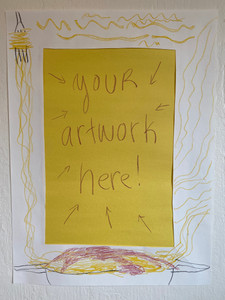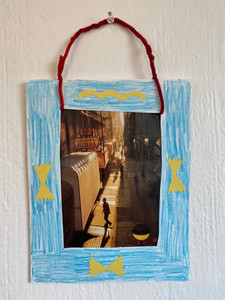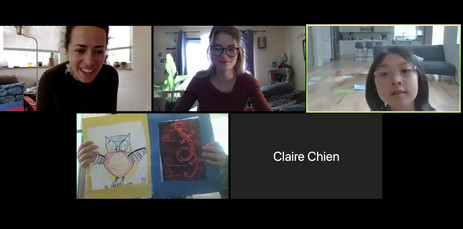Lesson Plan #3: Emotional Picture Frames (main teacher: Jessica)
- jta089
- Oct 26, 2020
- 5 min read
Lesson Plan #3 was for the students to create and "Emotional Picture Frame." The Lesson was adjusted for a Zoom lesson. Three students attended the Zoom, two of which were in the same Zoom call because they were brothers. The call began with an introduction to the project. A materials list for the Zoom was sent out earlier in the week, asking that the students have both the materials and an artwork that they would like to make a picture frame for. At the beginning of the Zoom call, the teacher asked that the students had the materials from the material list that was sent out, and then asked that the students share the artwork that they chose to create a picture frame for. The teacher asked that the students go around and say something about the artwork that they chose, before she began the further instruction for making the picture frame.
The teacher provided her own example when speaking about the next stage for the project, which was to think of symbols that you can use on your picture frame that connect to the artwork that the students chose. The teacher showed her artwork that she was working on, described the "feeling" that the artwork stems from, and then showed her own ideation sheet that had three different symbols that were connections and reasons that her artwork made her feel a certain way. The teacher then asked that the students write down or say how their artwork makes them feel or made them feel when they made it. Because of a feeling of lighter engagement at this early point in the project, the teacher became less strict about the symbols having emotional connections to the work, and more so stressed that the symbols simply have a connection to the artwork. Also, because the students seemed a little disengaged the teacher allowed for the students to just "say" their symbols rather than make their own ideation sheet for their symbols. One students used the Zoom "chat" to type what her symbol represented. She She wrote : "calm" and "happy". In the future, the teacher should be more strict with the ideation part of the process, and ask that the students create their ideation sheet in the same way that she showed in the example.
Teacher Example: Ideation
Zoom Call - showing ideation example
The teacher showed her specific artwork that referenced the wildfires happening in the state and asked if the students could identify anything about the work she was showing them. The students were engaged in this questioning, they responded that they saw a "map" then they responded that they saw "islands" then they recognized that it was a map of "Colorado." The teacher underestimated what the students were capable of, because the students said that this was obvious to them. They then recognized that the red areas in the teachers drawing were not "islands" but "wildfires". The teacher also used her ideation sheet as point of engagement with the students, asking them what they recognized the symbols to be. When is came to her symbol that was "eyes" she asked specific questions about the eyes and about their experience during the wildfires. Questions such as: Why do you think the eyes are drawn with those red lines? Did your eyes hurt or burn from the smoke? The students responded both yes and no to the questions. The teacher then described that she used this symbol of the red eyes because it was a memory of how her eyes hurt in response to the smoke, and also a feeling of fear from the event. The teacher also showed an example for a frame that connected to excitement she felt for pasta dinner with her family. For this she showed the students how she used the "pasta" as a symbol. The teacher could have asked the students to go further in depth about their own symbols. Since the frame itself was easy for them to create, spending more time on their ideation would have been beneficial for the project.
The teacher then showed how she used her symbol of the "eye" as a design to use on her frame. She then began the instruction for creating the frame itself. She show how to trace the drawing and then cut out on the line that they made. This was too easy for them, and in the future the teacher can make this part more complex and choose a better design for the object of the frame itself:
Teacher Example for use of "eye" and "pasta" symbol:
Teacher Examples: Eye Symbol
Teacher Example: Pasta Symbol
Zoom Call: Instruction for creating frame cutout
After instruction for how to cut out the frame, the teacher gave the students time to work. One student worked on the project far away from the screen so it was difficult to interact with her during the work time. The teacher let that student work without trying to interact so much because it looked like she was very engaged in her process of artmaking. It was also difficult to interact with the other two students that were brother as they were working because you can't really see their process as they are working. One boy was describing how he was using the "full moon" in the corners of his frame. Throughout the process the two boys that were brothers seemed a bit distracted with each other. They were jumping on top of each other and showing their cat to everyone in the Zoom call. The teacher asked that everyone let them know when they are done with their drawing or collage on their picture frame. When everyone was done, she asked that they hold up their picture frame to the screen. The teacher made observations of what she saw. She commented that the student who made cut outs used very soft colors and that her frame did make her feel calm. It was a little difficult to see everyones work and there for be able to make clear observations. It would have been better to ask specifically that the two brothers use a material that you can see better, even if it was marker or something that has a bolder line or more color.
Completed Picture Frames: (you can't see it well, but one of the students cut out her symbol of the leaf - using very soft colors - and used it in a line all around her picture frame)
Once everyone was done, the teacher asked if the students had any string that they can use to hang their picture frame. The teacher also showed her instruction of how you can use the string. The two brothers didn't understand why you would want to hang the picture frame when you can just tape it to the wall. The teacher responded, saying that maybe taping their frames to the wall may ruin wall. It could have been a fun "active" part of the lesson if the teacher asked the students to go around their home and find something they can use for the part of the project that involves hanging their frame.
Conclusion:
The teacher observed that this lesson was definitely too easy for the students. The teacher can make the frame more complex of a design for them to create and make the frame more useful, or useful for artworks or pictures that the students can swap out of the frame. The teacher observed that she needs to be more strict when asking the students to do something, for example, when asking the students to create their ideation sheet, she could have said that they had to create at least five symbols and that they have eight minutes to do this. She could have also created more rules such as that they had to use color. The teacher realized that it is easy for the students to get distracted and she needs to be able to call them back to the project and get them to refocus. The teacher also realized that doing Zoom provides lots of challenges to the lesson and for engaging with the students. For example, one student was very far away from the screen!
























Comments